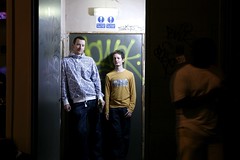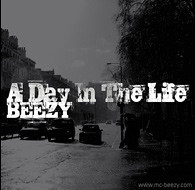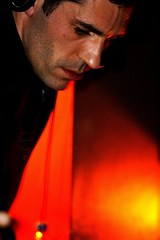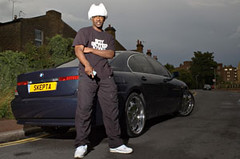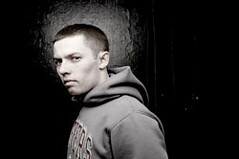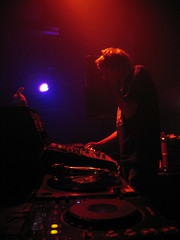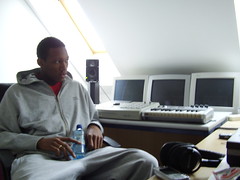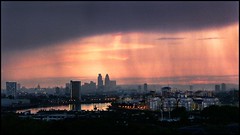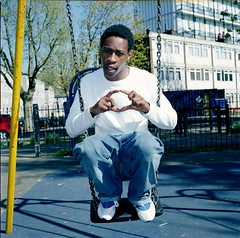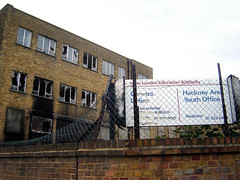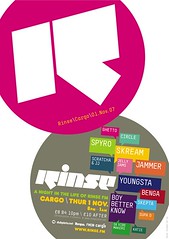Friday, December 21, 2007
Merry Christmas and Happy New Year
Dear 2007,
Merry Christmas and happy new year fella, have a good one, you've been a lot.
Dear 2008,
Watch your back, we're coming for you.
Seasons greetings,
Dusk + Blackdown
A bad day at the orifice
I've been meaning to mention for a few weeks, but Beezy's offering his second album/mixtape for free download over at www.mc-beezy.com. Production comes from a staggering list of dubstep & grime talent, including Kromestar, Cluekid, Cotti, Plastician, Shotz from OT, Danny Weed from Roll Deep.
"A Day in the Life" features several persy-ingles. "Say Yes" is a intoxicating sexual tale of seduction, with a hooky chorus. "Mr Dingaling" is the complete opposite: a dirty, flithy romp with hooks built from porn-samples. "You like that dontcha?!!" By contrast "My Documentary" is an introspective journey that sees a mournful Plastician beat artfully vocalled. Oh and it's the first studio tune to namecheck, um, me. Hold tight my ego.
I like Beezy; I like liking him because he divides people and winds up purists. Yet I return to his music time and time again. Each of his releases are better and stronger, such that his storytelling of dark violent encounters and twisted sexual episodes get yet more vivid and also, in their extremity, quite funny.
2008 should be Beezy's breakthrough year. He has another album, "Lost in Translation," in the can, featuring beats from Skream, Benga, Cyrus, Distance, Hijak, Coki and Lewi White. Beezy has a talent for getting quality album-productions out of producers who are often dancefloor focused. "Thoughts in Retrospect" is a bouncy, Benga-produced reggae-roller. "Snapshots of a Glass Portal" is Distance in stripped back, minimal mode.
Watch out for these, and Beezy the Twisted Story Teller, in 2008.
"A Day in the Life" features several persy-ingles. "Say Yes" is a intoxicating sexual tale of seduction, with a hooky chorus. "Mr Dingaling" is the complete opposite: a dirty, flithy romp with hooks built from porn-samples. "You like that dontcha?!!" By contrast "My Documentary" is an introspective journey that sees a mournful Plastician beat artfully vocalled. Oh and it's the first studio tune to namecheck, um, me. Hold tight my ego.
I like Beezy; I like liking him because he divides people and winds up purists. Yet I return to his music time and time again. Each of his releases are better and stronger, such that his storytelling of dark violent encounters and twisted sexual episodes get yet more vivid and also, in their extremity, quite funny.
2008 should be Beezy's breakthrough year. He has another album, "Lost in Translation," in the can, featuring beats from Skream, Benga, Cyrus, Distance, Hijak, Coki and Lewi White. Beezy has a talent for getting quality album-productions out of producers who are often dancefloor focused. "Thoughts in Retrospect" is a bouncy, Benga-produced reggae-roller. "Snapshots of a Glass Portal" is Distance in stripped back, minimal mode.
Watch out for these, and Beezy the Twisted Story Teller, in 2008.
Monday, December 17, 2007
Wot Do U Call It: Funky?

A few weeks ago, I headed down to Rinse HQ to interview funky/funky house DJ, Supa D, for the sleevenotes to his new compilation, the third in the series of Rinse mix CDs. What began as a simple fact finding mission decended into an unplanned, remarkable, state-of-the-'nuum discussion.
While the conversation began between myself at Supa D, key influential players began to contribute. First in came Rinse's Geeneus, then Ammunition's Soulja. Finally, with delicious timing, Bingo's Zinc wandered through to make a cup of tea.
Between them is a massive wealth of history and influence on London urban music in the last decade or more. Having DJed jungle, UK garage and bit of grime, Supa D is currently one of the, if not the, biggest DJ in the rising funky/funky house/Wot do u call it 2? scene.
Soulja began raving to UK garage, before embarking on a career in the music industry. She's signed the publishing of acts such as Ms Dynamite, So Solid, Dizzee Rascal and Wiley, spotting their talent at street level long before her peers. In 2001 she co-founded Ammunition promotions, Tempa and started Forward>>, the first club designed to showcase the then emerging underground sounds of dark garage/proto dubstep, breakbeat garage and proto-grime.
Geneeus was there at Rinse's inception, the day in the 1990s it first went on air, DJing jungle, and later UK garage. Having grown up with friends like Slimzee, Wiley and Target, he played a pivotal role in the birth of grime, as part of one of the genres' three founding crews, Pay As U Go. He's continued his involvement with grime and Rinse but has recently discovered a passion for funky.
Zinc made his name as a jungle and drum & bass pioneer and continues to producer and DJ d&b worldwide but has also collaborated with Geeneus on funky tunes as Moonshine. Around 2000 he inadvertently altered the course of UK garage with "138 Trek," taking d&b sensibilities and energy levels to a garage audience.
It was a halcyon era, where a tempo plateau around 138bpm saw multiple genres and scenes mixing and interacting, with the old school UK garage guard meeting the upstarts of raw proto-grime, dark 4x4 beats like DJ Narrows being mixed with Zinc-inspired breakbeat garage rollers, housey Todd Edwards-style 4beat mixed into proto-dubstep like El-B, Horsepower and Zed Bias.
Since then the various factions have either diverged or fragmented, occasionally interacting but seldom truly engaging in sustained dialog. Until summer 2007. Seven years on, suddenly it felt like there was another tempo plateau appearing again, not in London, but in Ayia Napa, the holiday destination of multicultural urban Britain, both north and south. Forced to entertain all types of ravers in the same rave, entertainers like Luck & Neat, Heartless Cru and most of all, Boy Betta Know, began mixing London grime with bassline house, London funky house with dubstep. Suddenly Coki and Benga's "Night" was the biggest tune in funky, and T2 found himself at number 2 with "Heartbroken."
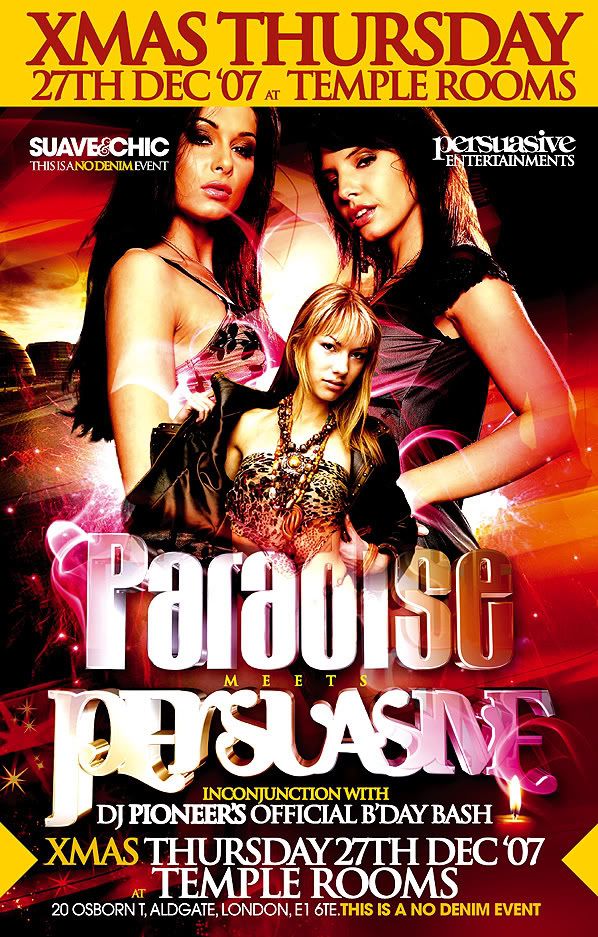
It's with this backdrop that I met Supa D. While much has been written about grime, bassline house and dubstep, there is a real sense of energy and enthusiasm around the funky/funky house scene. While house is in itself nothing new, with it's roots in the late 1970s Chicago and a massive global dance industry long since established through the superclubbing era of the mid to late 90s, the confluence of house beats with an urban audience seems like a change. While this first seem to begin summer 06, the momentum and enthusiasm around the scene is both refreshing, infectious and familiar. The key players dont even know what to call it - and history tells us Wot Do U Call It moments mean something's afoot.
While many of the players have seen all the recent nuum phases, funky feels uncannily like UK garage again. Watching it begin to unfold gives you deja vu, and not just because Supa D started on... Deja Vu.
This sense of familiarity, of a series of linear events leading full circle, is unmistakeable. Interviewing Supa D is like having both telepathy and visions of the future. You feel the echoes of the past and are able to predict developments.
There's a new urban scene in London: it's warm and housey, you can dance to it, it's vocal, girls love it, the clubs are all "no hats, no hoods, no sportwear," it's massive in urban london, there a big raves with 50 DJs on the lineup. The old guard love the US stuff but the new breed wanna make UK beats. So what's next? is the average age of involvement going to drop when the "youngers" get involved? Will the beats then get rawer? Will the MCs begin to dominate the vocal tracks before taking centre stage? Will the majors snoop around to sign vocal chart hits? Will the music mutate and become rawer? Will the chart hype kill eventually kill the scene?
Am I talking about UK garage circa 2000 or funky circa 2007?
It could be either.
A few people might have read my dismay when funky first reared it's head, summer 2006, not least because the chance for UK urban music to have a groundbreaking and popular genre of its own was being challenged. Furthermore the 4x4 kick is often a musical dead end, that once conditioned ravers will accept no alternative. Listening to Supa's CD, musically it's not that groundbreaking. But the excitement around the scene from it's players is infectious and the odds that it will evolve into something interesting, via its own "Pulse X" or "Capsule," are high - early bets are on Apple with his percussive, soca-ish sound.
Its also refreshing in contrast to the status quo. Frankly I've been sick of attending clubs this year to hear, formulaic, noisy, comically aggressive, soulless "dubstep" records made by faux angry boys, or not being able to attend grime clubs (with performances by men who's anger I dont doubt) because the Metropolitan Police have the powers to pre-emptively strike the chances of someone possibly committing a crime. If funky comes along and shakes all this up, I'm all ears.
There's been a lot of wingeing from the dubstep community over the adoption of funky into the Forward>> line up this summer. That winging is woefully shortsighted: I think it's a very smart move by Soulja and Geeneus. Whatever you think about the sound - as I've said, right now, sonically it doesn't seem that innovative - history has shown that the momentum generated by London's nuum is unstoppable, that when the community moves as one like this or like it did in the late 90s to switch from jungle to garage, it can't be prevented. You just have to go with it.
Now perhaps this might seem a little strange to people who haven't witnessed the pendulum swing like this before, but I've lost count of the people who've discovered dubstep in the last two years and now regret writing off UK garage. I've lost count of the number of times there were 15 of us on the Forward>> dancefloor - just as there is now when DJs play funky at FWD>> - raving to dubstep DJs who now fill stadiums. I've lost count of people who dismissed dressy UKG clubs as fake, too-girly or shallow, without truly understanding the communities that filled these clubs or the music that they made, who now play silly money on eBay for MDubs 12"s just because Kode9 dusted them off. What I'd say now is, don't make the same mistakes twice.
London has fertile musical soil and from it many exciting sounds and scenes have grown in the last twenty years or more. Their fate, however, has not always been the same. Jungle grew in this soil, but in the late 90s it cut its own roots and withered, so that now it's formulaic, noisy, comically aggressive and soulless made by faux angry boys (dont just take my word for it, ask Burial).
London has an uncanny ability for mutation and growth. By playing funky at Forward>>, the roots are being preserved and new seeds are being sown. "Moving forwards>>, never backwards," is the club's motto, not "dubstep til I die."
CD TRACKLIST BREAKDOWN:
At this point it's interesting to break down the producers on the tracklist:
Perempay was once Bossman from Essentials, Dee is Davinche from Essentials, Moonshine is Geeneus (sometimes Geeneus and Zinc), Donae'o used to do UKG and grime.
DelaCruz is UKG's Deliquent, Jay's Kitchen is garage's MC Viper and Simone sang an old garage tune.
The rest of the CD are new to me. They include Rinse DJ NG, Tadow and Fingerprint from south London's Invasion records, 1Xtra's Footloose, Matic a South London producer, Apple, MA1, Fuzzy Logic, Funky Junkies from east London and Naughty, a new DJ, part of HLC Entertainment.

INTERVIEW:
Blackdown: So looking at the Rinse mix selection, it's all UK producers. What's the thinking behind that?
Supa D It's something different. there ain't that out there, in the shops. you can't go to HMV and get a whole CD of up and coming producers.
B are they all London producers?
S Yeah, everyone's from London. That ain't been done before. It's something new.
B So, what would you call it - how would you describe the sound, loosely?
S To me personally, there ain't no special sound for it, cos it's just "house" to me. You might have the odd few tracks that you can say "that ain't house" and then you'd have to find a name for that - but the majority of it is house
B House has been going on for 25 years but you've definitely picked a particular set of tracks...
S It's a new era of it.
B it feels like it. The energy I get off you guys [Supa D, Soulja, Geeneus] feels like it's changing a lot quite now.
S Yep, it is. It's always something every week that sounds different. Each tune everyone makes, gets better.
Soulja Do you think they think they're making house?
S Yeah.
B What speed is it at?
S Between 126 and 130 bpm.
B OK. So when those guys play [originally-dubstep-now-crossover anthem] "Night" do they pitch it down?
S Yeah, they should have to, it's 140 bpm. What speed did you do your mix at Geeneus?
Geeneus 127bpm I make tunes at.
Soulja What do you think the ravers are calling it?
S They're all calling it funky house. Because that's how it all started and that name stuck into everyone's head.
G When see people saying things, they never say the word "house" though. They say they're "going to the funky dance." So I just call it funky now. Because that's what everyone knows it as. But it is true what he says, some of the tunes on the CD are house tunes and people like Fever would say "it's not house." But if Masters At Work made it, they would say it's house. Do you get what I mean? Because they make some tunes like us, like that tune that goes "ai! ai!" - that's the kind of tune we'd make.
It's not like standard house (hums 4x4 beat), so if that's house, then what we make is house. But then Apple: you cant really call that house. Even when I showed all the house people, even Dennis Ferrer - I emailed all the house people and gave them "Emotions" and that - and they say it's not house. They like it, but it's not house.
B The extra influence with the rhythm, feels to me like either soca or broken beat.
G It kind reminds me of garage. It's gone forwards and then jumped backwards. Because [UK] garage come from [US] house didn't it? It's gone off but it's coming back around again.
B But it's not come back around again with all the swing and syncopation though. The beats and snares are different.
G Everyone went back to the 4x4 kick. Whatever it is right at this minute in time it's house, but it's progressing into something else.
S I would say some of it, but not all of it. Because you've got certain UK producers you couldnt tell if they're UK or US.
G This is why I say it has got to be two musics: two musics are getting played at once now. Fever and that wont call what Apple and that make, "house."
B Is that because they like all the US stuff?
Soulja Yeah. They say that but they all play it because it gets such a big reaction in dances like Circle.
B Didn't we have all this infighting about seven years ago with people not wanting to play UK garage or breaky/Deekline-style garage instead of US?
G It's like a big circle
S They have to play it because they dont want to get left out.
G You can not play it and the dance wont get smashed.
Soulja I've still got the letter from Norris "The Boss" Windross calling everyone [in the UK garage scene] together. This was when it was UK garage and 2step and then Deekline and Zinc came along.
B Is there a loose divide amongst the funky DJs as to which style they'll play?
S Yeah they'll say so, but then play both anyway.
G You can't not play [the UK stuff] now, it's got to the stage where it's like these are the tunes that are smashing the rave and so you'd just be playing to a dead dancefloor.
Soulja Yeah because after that [funky house DJ] meeting at Rinse that time, it was the first time I'd heard Fever play all those tunes. He'd stood in Rinse and said "I dont want to be associated with it" but then played it. So Martin, when you get a label of a genre, do you think it's the scene it's labelling or the music? Because it always seems to me that, say when they tried to label "UK garage," there was so many different tunes from different areas being played...
B Mostly, there's not one rule. Sometimes it's the style of music and sometime's its just a collection of people. I always felt that grime was much more versatile if you said "grime is a given bunch of people [ie community/demographic]" than one actual sound.
G When they went from garage and started to change the names, it wound me up. First of all they called it "8bar." I said, "I can't say that I make '8bar'." You can't call a whole music scene that. And then it changed to grime and i think that there was a few of us who said, 'nah i dont make grime' but it wernt producers or DJs who called it grime it was journalists or something.
B I know people get really fixated on names and it's not what I'm trying to do here, but the problem is that house already is an existing genre that's been going since the 1970s Chicago Warehouse club, so how can we describe what's happening in London right now?
G The thing I've noticed from the general public is that they call it "funky" ...
S But it's not...
G ... you [Supa] would say it's not "funky" because it's not funky house [as the term is already known in mainstream dance circles]. So i'm saying there's a whole different thing, called the word "funky". People are losing the word "house" and calling it "funky." People say they're "going to the funky dance" or "that funky tune." So the public are naming it just "funky."
B It's always the best way when the public name things [and journalists dont force a label on a genre]. It's also the case that in my experience when there's something going on that has no name, its the best possible moment. It means the rate of change is the greatest, like when people were making "8bar" - the foundations of grime.
G You see my tunes like "Emotions," what would you put that under, house or funky? Because people say its funky...
S You can't say that to me because funky to me is all Hed Candi stuff.
G Nah, that's funky house. Forget the house thing: people are just calling it funky. The thing is, music evolves and every time the music evolves, the name changes. So this music that you're now the leading DJ of, is evolving. So by abbreviating it, it becomes its own thing. What you don't want to do is say you "only play house" and then the whole thing evolves, because actually you're at the front of it.
S I'd rather say that.
G I'd say, go with it, wherever it goes. You can't change what the public do. Like with dubstep, at first everywhere I went people were saying it was called "Forward>>".
S The name "funky" is already there though.
G Funky house.
BB My only problem with it is it sounds like you mean all the filtered disco stuff. It's all gone a bit "Wot Do U Call It" which is always a great moment.
Soulja All my friends say "I'm going to a funky dance."
G ...and it's going to be harder to convince them that its house than to just go with "funky" and be the leader of that. Because no matter what your feeling of it is, you can't change the change. It's impossible.
S What I'm trying to say is for me, not everything comes under that bracket. Only certain tunes can you say 'that ain't house.' The Rinse CD is a mixture. It's all UK: some of it you can say, yeah that's proper house.
G It's like a new sound that's evolving. Tunes like "Emotions" and what Apple makes is getting further away from what Dennis Ferrer and all them make. But Masters at Work make kinda similar stuff to us, which is why it all gets kinda confusing.
S Me I'd rather just call it "house."
G The only problem with you calling it house is the serious house people, when you call the UK stuff house, wont take you that seriously because the big people are big already. But if you were the leader of a thing that's not got a name, you'd be the biggest in that whole scene. But you can't be the biggest in [mainstream] house, because they're already the biggest. No matter what you do, you're not going to beat them.
Soulja Supa, are you the biggest DJ in the scene that you're part of?
S Yeah...
G But you can't say you're the biggest in house?
S Nah, I wouldn't say that.
G If you accepted it to be called "funky" you'd be the biggest funky DJ there is. You'd be the top boy and no one else could touch you. But as soon as you call it house, you go from up there to down there.
B You've been through this before with grime v UK garage, haven't you gee?
G I have been through it and had to fight it as well!
S I just wouldn't call it funky...
G Thing is they called it "grime" but what the fuck does that mean? Doesn't mean nothing. But the name just becomes a name for the music - and what does the name actually have to do with it anyway? It's just like a label, an identification. So I'd say call it "funky" because that's what the public call it and in a minute someone will call it something else, like "ghetto house." For a minute someone thought what we were doing was called "bassline house?" And we get put into that, and we're nothing to do with that.
B That's a north or south of the UK thing.
G Journalists will start to call it something if we don't quickly say what it is. I say call it "house and funky" because you do play house but when you play Apple, people like Fever say we have no right to call that house. So it's "house and funky" like it was "house and garage".

B Can you tell me about some of the parties?
S The majority of the time everyone's movin', everyone's bubbling, getting down. I enjoy a rave called Circle - the last one was in Brick Lane. Some of the places are dark and dingy, but they're the best atmospheres, like certain after parties. You can play new tunes. There used to a place called Jam Bar and Monestry in Forest Gate. They're dark but they have the best atmospheres.
G There was a bit of trouble in there, it got locked off.
S They try and put a different afterparty on every week, all over. More east and central. There might be afterparties at Departure (in Whitechapel).
G I find the ghetto-y ones, the dingy ones, have better atmospheres. I played an r&b event, with people all dressed up and looking nice and I couldn't wait to get out of there. The atmosphere was dead.
I went to Papermill on Curtain Road in Shoreditch and it was grrrrimey in there, bare ghetto people in there, but the atmosphere was heavy, just shocking out to new tunes and everything.
S When you go to certain places where they have newcomers, just come from the r&b scene, you know what you have to play. You have to play commercial, what they want to hear. But the people who rave to funky every week, they're more open to new tunes.
B So Circle - where else do you like going?
S There's Rinse's new rave called Casa Funk. That's going to be the new big one.
G That's paving the way of the [old, large UKG raves] kinda Costra Nostras and Sun City's.
S Funky Love, that's normally alright. It's all over the place. It started off in Hackney Central but that venue's closed down now.
B The after parties bring another parallel with the birth of UK garage because didn't lots of UKG start in after parties near Ministry? The after hours parties for the people who couldnt get into Ministry.
S It's like a big circle isn't it?
Soulja A lot of people talk about Grays Inn Road. We should do a dance called that.
Soulja Grays Inn was so important. If that club wasn't on... it was a different audience, served up in a different way. It was every Sunday for at least a couple of years. it was all based around a couple of DJs and they kept playing for hours and hours - Funky Smith, Daryl B sometimes. And Charly Brown used to MC, but he's dead now. And Gemini. I used to go there every single week, religiously. You
didn't even bother to go out on a Saturday night. You'd get up at 5 and go to that all day - amazing.
B While lots of the elements of house have been around for a long time, it feels like things are evolving and changing a lot right now. But why now?
S It's just like when everyone went from jungle to garage. This is the next thing, innit?
Soulja Is it boredom, do you think?
G Do you know what i think that is good about this music, that we havent seen since garage, is that it's actually dancing music.
Soulja It's just raving, more sociable.
G Grime: when we got involved we kinda pushed it further and further away from dancing. Tunes like [Danny Weed and Cage] "Creeper" and all that, you can't dance to them. People just stand there.
B Or Wiley's devil mixes...
S No beats! But this, you have to dance to it.
B So do you think funky is a reaction to grime being more like a show that you watch than something you get involved with and dance?
S Yes, with the people that crossed from that side of things, but not everyone in funky came from there. I've spoken to a few people though, and they're like "there's no grime raves away."
G There's no raves and no girls. And grime's all about MCs.
S You dont have to have MCs in funky, you can play music all night.
G And you get the same response.
B It's definitely a shift to return the power to the DJs again.
G It's a DJ based music.

[After the interview, the issue of why there were so many white girls on the flyers. It was generally agreed that white girls were used because if they'd used black girls, stylistically it made the flyer look like it was for a bashment rave.]
B Tell me about the dress code - because again, this feels like garage. No hoods, no trainers etc.
S It's to keep it like a nice environment. The only place you're going to get away with hats and hoods is them afterparties. But when you go into the places where you have to wear [smart] trousers but no trainers, it looks good, you feel like you want to dance, everyone just behaving themselves.
Soulja The girls dress up more.
G People make more of an effort because the girls are making an effort. There's definitely more girls.
Soulja Bare girls. What's the ratio?
G At Casa Funk, I thought we weren't going to get no men!
B No men?!!
S Coupla girls were moaning at me: "there's too much girls". I'd rather too much girls than not, because it stops guys from looking at each other. Girls aint going to start fights... well they do, but not as bad.
B The mainstream house scene has a long association with ecstasy, which you dont see in grime. Is there any of that going on in funky?
S Yeah, a bit. More in the after parties.
Soulja They seem like they're drinking more, in the main events. Wine, champagne, getting tipsy and cracking up laughing. Seems like a drunk thing.
S Afterparties are more e's and sniffing.
B The grime boys never seemed to be into pills, ever.
Soulja It was more about weed. Same as dubstep really.
S Thing about funky is you got to keep your energy up, to keep dancing for six hours.
Soulja I was suprised at Casa Funk how the energy levels were really hype and everyone was really happy, a bit drunk, but its because of the tunes.
G When we went to Circle the other day, I felt not good, I wanted to go home. But 20 minutes in there and I was shocking out. I didn't wanna go home.
Soulja Everyone's acting like it's a celebration, going out to dance.
B In a grime rave, audiences would never allow themselves to let go, go crazy, shocking out.
G Garage going into grime kinda got lost, because it went into Sidewinder. Our main focus [in Pay As U Go] was to smash that rave and Slimzee would smash it. And the MC's main thing would be to say a lyric and get a reload. Whereas the house thing it's not really about reloads. It's just continous dancing.
B Are there no reloads?
G Very occasionally. A couple, here and there. But in grime every other tune's a reload. But nothing gets a reload in house because there's no MCs asking for it. To get a reload, the tune really has to smash it. For reload you'd see the whole crowd shocking out.
B With grime at Sidewinder, MCs could make a tune big just by getting a rewind on that tune with their biggest lyric...
G This is the otherway around. Big tunes are just big tunes.
B So with this weird symmetry, with us being able to see where garage went with grime and yet feeling like we're back, before all that again, do you think with people like Apple going raw and percussive, will it be too long before people go darker in funky?
G Yeah I've made a couple of dark funky tunes, with grime sounds in them. But i still think it's not about the sounds but the drums. The drum pattern keeps you dancing. The monotonous sound of the 4x4 kick keeps you dancing all night, and while there's load of other things going on around it - percussion and different snare patterns - in this music it's always about the 4x4 kick, in the way dubstep always has the snare on the third beat.
B Mainstream house already had it's kick-hat-kick-hat-kick-hat-kick-hat formula but funky doesnt seem to be going down that pattern...
G The main focus is that we all keep the 4x4 beat. But everything else is: do what you want. There's no other rule except that 4x4 kick.
B That's healthy.
S If it ain't got that 4x4 kick...
G ... then it aint really nothing to do with this.
B So this year, although it's been around for a while, a lot of the media have picked up on northern bassline house, ie from Sheffield, Leeds etc. Do you have any interaction with that scene?
S I don't. But funny enough, I play out up north more than before. From now until the end of the year I'm out every week up north.
G That's because of Ayia Napa crossover though isn't it? It's the place that crosses all the musics.
B Thanks to Boy Betta Know...
S As soon as people came back from Ayia Napa, people were asking me to play T2s "Heartbroken". And I'm thinking, "that ain't house..."
B And [Benga and Coki's] "Night?"
S In certain raves, people call that funky house.
Soulja Major labels have been ringing me to get funky house remixes from Benga and Coki! I'm like, "you've got the wrong people..."
S You could probably play a bashment tune in a funky house rave and it would get called funky.
Soulja It's like that point in UK garage when Azzido Da Bass was called garage. Or Zinc's "138 Trek," and then there's people saying "this isn't garage."
S At the time, I would have called that garage myself. So what was it?
Soulja It was just a cross genre tune.
B Slowed down drum & bass?
Soulja It was just an experimental tune that many different people took to, same as with "Night." Drum & bass DJs are playing "Night" but they wouldn't call it drum & bass.
[with great timing, Zinc wanders through to get to the kettle...]
Zinc: I play "Night" in the middle of my sets, and then I play my remix.
Soulja Shy FX is playing it.
B I can't think of anything else in drum & bass that's 140 bpm...
Zinc: People have been playing dubstep records for a while. Marky plays Mr Oizo's "Flatbeat."
S Now, I'd play that in a house rave, still. It's house but some people think of it as garage.
G We played "138 Trek" and thought it was our scene that made it massive but it was getting played in all these other scenes, that we had no idea about. Like Benga's tune, we know it as dubstep but a lot of people think of it as funky.
S Same as certain electro tunes like Bodyrockers people were calling it funky but it's an electro tune. But it's only certain tunes that cross over.

B Do you get booked by the commercial house clubs? Are they interested in what you're doing, Ibiza and all that...?
S More out of London, not in London.
G Big record labels have been sniffing around though. Since Ayia Napa - everytime it happens it changes everything. Every year.
B This year seemed like a bigger change than most though.
G Yeah yeah, the past three years it aint really changed that much. It's because the [northern] bassline and the [London] funky house got mixed into one, and they're both quite underground, ghetto kinda thing and they got to see each other's scenes.
S Now, when I get booked up north, I get booked at one of those Niche raves and I'll be doing the house set.
G It's good because it means the music is spreading outside of London.
B It's good because grime never really got a strong foothold up north did it? They didn't start crews that really went anywhere...
G The thing about Niche is was a kind of leftover of garage as well. Everyone was telling me about bassline about two years ago. Agent X were saying "up north they love bassline." Sammy B from Boy Betta Know was saying it.
S There's certain tunes from ages ago that you can play in a Niche rave now.
B Narrows?
S Yeah. Even that Dynamite tune, "Ramp."
Soulja Gemma Fox's "Messy" is big there too.
B With the funky stuff, how often do you play with MCs?
S Occasionally. There's only a handful of MCs. Probably about four. And I dont have any tunes with MCs on them.
B I've seen (grime's) Jon E Cash's name on funky house flyers...
Soulja What was he calling funky?
G They were calling it "future sounds". It's the same thing he tried to do with "sublow".
Soulja That worked OK with sublow for a bit
G They had a little meeting with Slimzee, Cameo, Jon E Cash. Slim told me about it: they had it in Nandos. They discussed the future of the music and what it's going to be called. Cameo said "sublow." Wiley said "eskibeat."
S He told me he had this "future sounds" tune for me. I've been waiting a year.
B Guys are definitely leaving grime to do this. How do you think this is going to affect grime?
S All of them in grime are trying it at the moment.
B So there's Jon E cash, Bossman, Wiley, Target, Danny Weed, JME...
S Jammer's trying it. Da Vinche.
G I could see Da Vinche working though.
S All their stuff is good quality.
G Thing about garage was it was all good quality production. Steve Gurley and all them...
B There were lots of bootlegs though. So Supa, do you play CDs or vinyl?
S Mostly CDs, though I know most of those tunes wont have been mixed or mastered. Certain places dont even have decks.
G The other day I went out without a record bag for the first time ever.
B There's definitely going to come a point when that's standard.
S Yeah.

B So you've been on house for a while, how do you react to lots of people coming in from different scenes?
S I just look at them like they're following fashion, but more the better, innit?
B And what will you do if it follows exactly the same path as garage into grime, with the MCs jumping on it and taking control?
S That's where it comes down to the DJs to put a stop to that.
Soulja Ahha, I've heard this before as well!
B That's exactly why I'm asking, it feels like we've seen this before!
S There's been times when I've had to take mics off people. And if they come on my set they know it's not about MCing, but talking, because he knows what man will say to him, because we've had to do that.
Soulja Currently, thankfully, the MCs that are around in funky have been around for a long time.
They were in the garage thing. Spidey and Gemini, who's been around since Gray's. I was so shocked when I went to a Red Carpet rave two years ago to see Gemini on the mic. The same dude. That rave was a different crowd, weren't at Grays, similar performers with similar style of MCing, the afterparty style to a bigger audience.
B Is this an older or younger crowd?
S I'm seeing the new generation coming up, listening to funky now. Where before they used to be on the grime all the time, they're moving starting to go to funky.
G Girls would rather listen to funky than grime.
Soulja Girls are not going to go to grime and rave, are they? Never really have.
S I see it getting younger and younger.
G I dont think the MC thing is going to happen so quick with it anyway. If Jammer went into a funky rave and started doing "Merkle Man" the crowd would go into stand still mode. They wouldnt like it at all.
Soulja At least there's an outlet. When So Solid and Pay As U Go came about in garage, there wasn't another outlet for the MCs. Whereas at least now grime's still fairly healthy.
G Grime's got it's own weight, it dont need to run over to funky.
S But a lot of them do try it in a rave, MCing. I see it, but you have to put a stop to it, straight away. Bare times had to unplug mics and stuff. "The mic doesnt work." But if the main DJs dont let them do it, then it wont happen.
Soulja I dont think the ravers would like it.
G I like the MCs that are in it, Spidey G, Dogtaniun. Tippa's quite funny.
S Gemini's quite funny. When a DJs playing a tune you're meant to know he says "these teletubbies, they don't know."
B So when did you start DJing Supa?
S I started off in jungle. That was about 13 years ago. After that I went to garage, getting into a bit of grime and that but as I was playing it I was buying house at the same time. I was on Deja Vu at the time but i couldnt play it. I was scared to play it. Then all the change happened when all the grime lot got kicked off Deja Vu. Then I was playing more old school garage. Then one Christmas Day I did a
whole house set and from then I kept on doing it.
B When was this? Because the MCs getting kicked off Deja was about, what, 2002-03?
G They didn't get kicked off. I phoned them up and told them to come back to Rinse. We were in a studio in Three Flats, so it's got to be 2004.
S Yeah, It was 2004. So I was buying house but couldnt play it. But I've been working in a record shop since I left school, Wired For Sound in Hackney, since I was 16. I used to get everything, garage and then house. I kept buying it, at cost price, but couldnt play house out or on radio.
B So when did the switch come?
S The switch came I started playing old school and then my house collection got big enough I thought I'd start doing that, on radio on Christmas Day.
G Do you think radio has influenced this new rave scene? It couldnt have happened if you hadnt done that radio set - so it started on radio.
B I'm sure grime grew because it was all on radio, with no raves, they could take risks. Get away with anything, without a crowd.
G Yeah. I dunno... it was like a fucking rave up the radio!
Soulja Geeneus and I will like the same big tunes, but I will have had confirmation by seeing them in the rave, whereas he would know just by the heat on the radio.
G So when everyone said "this funky scene wont get big, police are locking off the raves," I say I've seen music get big without raves.
S The raves have been happening even before I joined.
G Like Big in west. And Jam every Sunday.
S Aquarium too...
G ... before it started getting a bit ghetto.
S Now, see the raves like [mainstream, US-centric house club] Soul Heaven, all the people who have jumped on it will start going to them raves as well now.
Soulja I went there a few weeks ago, I was surprised. It was like regular Soul Heaven, commercial, white people, not very good dancers, same clothes, over and over again. Then you have more of a mixed crowd, black people, white people, little bit sharper, better moves - they've decided to go to Soul Heaven because there's nothing on in funky, and they'll hear a few tunes dotted in it. And as soon as the DJ plays the tunes that are getting showcased in funky, they're reacting. Wigman was there.
B So who do you rate as the top funky DJs?
S Me, Pioneer, Kismet, Wigman, Footloose, MA1, I.C., Fever,
G What about Statix?
S See, they're more underground.
G Proper underground.
S Big on the after party scene. When it gets really grimey: it's them.
Soulja Wigman's really an afterparty DJ.
S His name's big still, but more on the afterparty scene.
B But you rate the afterparty scene?
S I do rate them but i wouldnt really wanna play there. I try not to, only certain places. Because they're the places where trouble. You go in there and you think there's gonna be trouble.
Soulja The police are watching them.
B That's funny because perhaps some people might think with funky being all dressed up, kinda the opposite to grime, there wouldnt be any trouble?
S It's just the whole afterparty thing. I think that's like that with every afterparty.
B Has funky had the same problems with the police watching and closing raves in the way grime has?
S Yeah. Cos it's like the new thing, it's happened quicker than in garage. Because everyone's jumped on it quickly and it got all big quickly. And then trouble starts quickly.
B I also think the police are more organised now.
Soulja That Grays Inn Road thing used to be troublesome. At least once a month the whole rave would be fighting. There'd be a massive fight and someone would get dragged into a corridor but there was never any police. The whole of Grays Inn Road, off Holborn, would be full of cars. Complete roadblock.
S But now when they do afterparties they organise it the same day, you'll find out about it the same day. You'll be raving, get a text and go to the afterparty. Text, thought sometimes it will be a cheap little flyer they give out in the rave for that night. They're somewhere different every week now.
RINSE03: Mixed by Supa D is out soon. Casa Funk's 12 Hour Special is on New Year's Eve at Club E3, Mile End.
MYSPACE LINKS:
· Supa D
· Apple
· Circle
· Kismet
· MA1
· NG
· Pioneer
· Invasion
· Butters boy PR
· Wigman
· Statix
Monday, December 03, 2007
A years worth of words
Dec 07
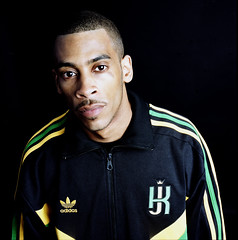
The End of Year Pitchfork column from me, including my top 25 or so dubstep and grime tunes of 2007.
Nov 07
The penultimate column of the year featuring JME, Skepta, funky house, Burial, Untold, Ramadaman, Pangaea, Narcossist, Anti Social Entertainment, FWD>>'s 7th Birthday warehouse party, Beezy and of course Martyn.
Oct 07
This month features Lewi White, Ghetto, Peverelist, Burial, Guido, Quarta 330 oh and some guy called Pinch. Check also the first in a new series called Words into Sound.
Sept/Aug 07
This month features Skepta, Dysfunktion, LV and The Bug.
Jun 07
June features Forsaken, Pinch, Geeneus, Rinse, UKRecordshop.com, bassline house and Flying Lotus.
May 07
May including interviews with Martyn, Appleblim, Plastician, Tanya and the Grime Reaper.
Apr 07
This month's column is a grime special featuring Ny, Trim, Skepta and more. It's... a lot ;)
Mar 07
This month features Joker, Surya Dub, Sub Swara, Skepta, Scorcher, Durrty Goodz, and DMZ v Dubwar.
Feb 07
It's column time again, this month on D1, Beezy and Wiley.
Jan 07
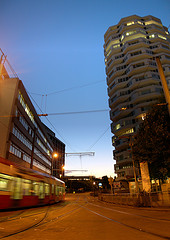
First column of 2007, focusing on the BBC's Sound of 2007 poll and the Dubstep Forum Awards.

The End of Year Pitchfork column from me, including my top 25 or so dubstep and grime tunes of 2007.
Nov 07
The penultimate column of the year featuring JME, Skepta, funky house, Burial, Untold, Ramadaman, Pangaea, Narcossist, Anti Social Entertainment, FWD>>'s 7th Birthday warehouse party, Beezy and of course Martyn.
Oct 07
This month features Lewi White, Ghetto, Peverelist, Burial, Guido, Quarta 330 oh and some guy called Pinch. Check also the first in a new series called Words into Sound.
Sept/Aug 07
This month features Skepta, Dysfunktion, LV and The Bug.
Jun 07
June features Forsaken, Pinch, Geeneus, Rinse, UKRecordshop.com, bassline house and Flying Lotus.
May 07
May including interviews with Martyn, Appleblim, Plastician, Tanya and the Grime Reaper.
Apr 07
This month's column is a grime special featuring Ny, Trim, Skepta and more. It's... a lot ;)
Mar 07
This month features Joker, Surya Dub, Sub Swara, Skepta, Scorcher, Durrty Goodz, and DMZ v Dubwar.
Feb 07
It's column time again, this month on D1, Beezy and Wiley.
Jan 07

First column of 2007, focusing on the BBC's Sound of 2007 poll and the Dubstep Forum Awards.
Sunday, November 25, 2007
Geiomix
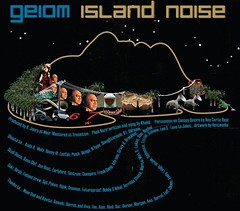
In a follow up to my Geiom interview, I have a specially commissioned "influences" mix by Geiom to share. With his album "Island Noise" out now (check "Phlei Nasir", it's nuts!), Geiom has kindly taken the time to assemble a diverse mix and describe what each track means to him.
DOWNLOAD the Geiomix here
Joao Gilberto – Manhã de Carnaval – 1959
“From the film Black Orpheus – this is what got me started on Brazilian music – well bossa nova at least. Bossa nova always seemed childlike at first but some of the main characters were actually quite debauched.”
Kishore kumar – Koi haseena - 1975
“Demonstrates a very fertile period in Indian pop – no fear of using funk guitars or mad synths in a tune. Sadly these days the western influence often just means a ‘dance’ beat or a rap section in English. It’s from one of the most popular Indian films ever, Sholay. I heard this a lot when I was growing up.”
Raymond Scott – Backwards overload -1968
“Genius electronic sound art from an era when only a few people like Mr Scott could make this stuff – Using instruments the size of a car, specially designed and built by himself and Robert Moog.”
Bjork – Scatterheart – 2000
“Truly visionary artist who always stays ahead of the game. From the film Dancer in the Dark which I found a bit crap (!) but also very emotional.”
Sweet Exorcist – Clonk - 1990
“Weird bass music from Richard H Kirk, who was half of legendary synth duo Cabaret Voltaire, and pioneering Sheffield producer DJ Parrot. The album ‘CCEP’ is a tripped out masterpiece. Sounds outrageous on a good system.”
4 Hero – No sleep raver - 1991
“Very unusual rave era tune that sounds more latin than ‘ardcore…4 Hero on some next level tip. The sample is from a wicked tune called ‘Friday Night Saturday Morning’ by The Specials. Terry Hall always makes interesting music – his more recent stuff with Mushtaq is top.”
Kosmik Kommando - ? - 1993
“All the things I like about acid music – relentless weaving synths expertly tweaked. Makes me think about strobe lights and sunrise.”
Plaid – Angry dolphin - 1995
“Great example of how you can mangle beats but still retain the funk. Totally inspirational producers.”
Sun Ra – Planetary search - 1980
“Crazed keyboard action from the outer space master.”
The Upsetter – Bird in hand - 1978
“Reggae likes to have a go at every style and this Lee Scratch Perry tune cleverly blends devotional style Indian melody over a sick dubbed out riddim. “
Goofy – Pack bus dem - 2000
“Pure joke tune – classic beat with the hilarious Goofy complaining about overcrowded Jamaican public transport. I love having ragga tunes on 7” vinyl – it’s a shame its dying out.”
Biz Markie – Just a friend - 1989
“Everyone loves this tune – its stupid but great ! We get treated to the inimitable Biz singing over a cheesy piano riff in this gently rocking hip hop classic.”
Paris – The devil made me do it - 1989
“From a big album with menacing lyrics that actually have some meaning, which can be a bit lacking in Hip Hop these days. Paris got in a lot of trouble for his politics but is still on it. Sick reversed backing track.”
Microstoria – Endless summer - 2000
“I became immersed in very minimal glitchy music around this period and these guys were maybe the best at it. I think one of this duo started out by damaging CD’s and sampling the results. They went on to turn the idea into an artform in its own right.”
Fela Kuti and Ginger Baker – Ye ye de smell - 1971
“The length of most Fela Kuti tracks is crazy ! – but the band is always tight and constantly inventive. I love afrobeat as a live experience but this is the next best thing. Pure energy as the king of African funk meets up with master UK drummer Ginger Baker in Nigeria and turns out a timeless album.”
Ennio Morricone – Esplicitamente Sospeso - 1973
“This is proper scary. We saw Morricone conducting a special concert on his 75th birthday - he is a badman. Despite being best known for epic catchy film themes this demonstrates that Mr Morricone is just as deadly with abstract dronescapes.”
Joy Division – Passover - 1980
“I love the way that Joy Division are bleak but still really tender. The production is cold and metallic and Ian Curtis’s voice is kind of robotic and it all combines to evoke something unique.”
Mazzy Star – All your sisters – 1996
“The singer in Mazzy Star (Hope Sandoval) has one of my favourite voices. Lush track.”
Kraftwerk – Ruckzuck - 1970
“From before Kratwerk went totally electro. I remember stuff like Tour de France from breakdancing as a kid but I discovered this side of them much later. Sounds almost like a live band with some tight drumming and mashed up flute/synth riff.”
Stevie Wonder – Evil - 1972
“Stevie in his best era plays every single instrument by himself to produce a nostalgic tune packed out with amazing vintage keyboards.”
Timmy Thomas – Why can’t we live together ? - 1972
“From an odd lo-fi album by a guy who only plays Hammond organ and drum machine for every track - it sounds like its recorded in black and white but the vocals and melodies are pure sweetness.”
The Stylistics – People make the world go round – 1972
“I got into this backwards – there is a cover of it on a Carl Craig album which I loved, then I discovered the original. Slick instrumentation from the days when pop music had full horn sections and stuff.”
Read the full Geiom interview here
Voices lesser heard
One of the most frustrating aspcects of the debate around urban Britain's young gang/gun crime problem is the lack of voices by people actually involved or affected by it.
Yesterday, The Guardian published a series of transcripts of interviews with teenagers involved with gang and gun crime.
No matter how harrowing, it's at least good to see genuine first person accounts being published, rather than the debate being dominated by people totally removed from the causes or effects of the situation.
I think the most powerful quote from this reporting is the following:
Yesterday, The Guardian published a series of transcripts of interviews with teenagers involved with gang and gun crime.
No matter how harrowing, it's at least good to see genuine first person accounts being published, rather than the debate being dominated by people totally removed from the causes or effects of the situation.
I think the most powerful quote from this reporting is the following:
"A lot of middle-class people think that gangs are untouchable and youths are unreachable, but that's not the case - these 13- and 14-year-old boys are scared, they are looking for guidance and they're going to anyone who can provide it."This isn't from the journalist who wrote the piece or some MP. It's from a 19 year old who saw his first murder at 7 and has witnessed fourteen since. We live in serious times.
Thursday, November 22, 2007
The eyes 'ave it

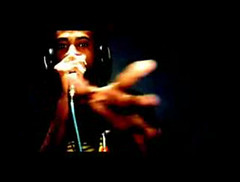
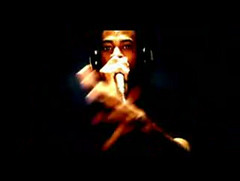
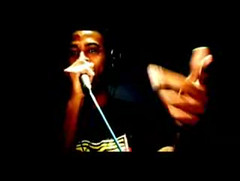
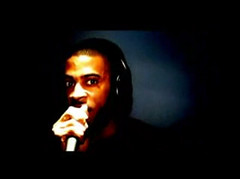
I don't normally post YouTube links but this video of Goodz is too much. One take, lit from above: he makes this any-beat sound like it's the anthem of the year. But it's all about his eyes. Just check his eyes. Pure fyah.
Wednesday, November 21, 2007
Metadub
On Thursday night I headed down to Metadub at Plastic People. The lineup was ridiculous: Appleblim DJ set, Shackleton live, The Bug ft Ricky Ranking, Warrior Queen, Flowdan and Killa P, Kode9 and Spaceape live. It was a night of Dubstep Visionary Allstars. I caught the end of ‘Blim’s dubby set, including some nice straight 4x4 housey tracks, before he gave way to Shack, live.
There’s something relentlessly fierce about the Shackleton sound, especially live. It’s totally no compromise, from the lack of breakdowns to the constrained sound palate: pitchbent sub, sharp percussion, jabbering just-out-of-earshot vocals and occasionally the odd synth/riff, but little more. If it had been made in the 80s, people would have drawn parallels with Thatcher’s Britain and seen punk style anti-establishment undertones. But in these apolitical times, it just seems like one man’s determination never to concede an inch.
Shackleton’s sound pushes my pleasure/pain boundaries, gets my head moving as fast as my feet and leaves me with a deep sense of respect for what he’s doing, though I do feel that sometimes I can reach an exposure limit with it. An hour long live set was full on.
On his recent Mary Anne Hobbs mix, he was described as someone who operates ‘on the fringes of dubstep.’ and perhaps in practical terms, it’s true. But yet Sam’s approach is totally central to everything that dubstep can and should be, and every new producer coming into the scene should watch how Shackleton developed his sound.
Firstly he spent time, like any enthusiast, down at the front of his chosen club by the DJ booth, which as symmetry would have it, was Plastic People, the very booth he’s now performing from. It’s said that the track that seemed to leave the biggest impression on him was Mala’s “Conference,” perhaps the Hatcha anthem during the era that his headlining FWD>> sets shaped dubstep as we now know it. Built from rolling congas and bongos, you can imagine this as a starting point for the Skull Disco sound, a kind of seed from which his untamed jungle grew.
But then Shackleton did what pretty much everyone in dubstep who wants to produce should do. He began to imagine the next step and the one beyond that. He asked himself, ‘how can I make this mine?,’ rather than Mala’s. He mutated “Conference,” rather than cloned it, and developed his own sound that you can now clearly hear as unique to him. Now I’m not saying this is easy to do, but it’s something everyone should be aiming at.
Recently here’s been a few people suggest that Shackleton isn’t dance music. I disagree. It’s just not DJ music, and that scares and confuses DJs. To me, a good selector shouldn’t be afraid to edge roll a tune: your selection as a DJ is just as important as your ability to make two tracks not sound like a horse galloping for ten seconds. And with DJs rewinding every other track right now, who cares if the next one is faded in if the last eight were pulled up?
A man who knows a few things about no compromise is The Bug, as his recent interview on the Boomnoise and Poax show will attest. While I liked the first Bug album, over the years a lot of his stuff has been either slightly too hard, industrial or noisy for me, but recently he seems to have found a perfect balance between impact and depth. And while I’ve seen him perform a few times, this was definitely the best I’d heard.
The Bug has a very refreshing attitude to DJing. Using Final Scratch, he loads up either riddims he’s made or ones that fit his style from, in this case, grime, dubstep, hip hop, dancehall or dub, and lets them off. When their impact is waning, he’ll make no attempt to beatmix, instead either hitting soundeffects or doing a spinback of the track, before rolling the next riddim. As I say, it’s refreshing, coming across like The Bomb Squad were doing his segues.
Some of the tracks he opened with hinted at real gems, including two Spaceape vocal tunes, including Cult 13’s “Wickedness” that set off my “what the...?” alarm. Others, over the physical Plastic People soundsystem, illustrated a wonderful sense of raw minimalism, such that the few elements that were chosen, and where they were placed (esp. if you can ‘read’ beats), had fantastic impact.
But this was just the beginning. Soon added to this rich mix came four very different MCs, that represent different sides to The Bug’s sound. First there was Ricky Ranking, an old school sing-jay in a reggae tradition. Older than the other MCs, he sang short, sweet, repetitive refrains over different riddims, ephasising respect and unity. Warrior Queen, all sassy and sexual-aggressive, was exhilarating as ever. Then in came Flowdan and Killa P from Roll Deep, all gruff grime menace, with a dancehall edge. Ricky and Warrior took the mics into the crowd in front of the DJ booth, and with crowd forming a tight circle around them, there was a glorious dissolution of the artificial barrier between the performers and audience. Who would have thought you could have caught a wiff of Carnival at a Wire night?
In many ways, the difference between the performers’ styles and fashions was visually manifested by their attire. Warrior Queen wore a tight but, with little tassels, teasing outfit. Ricky Ranking was sporting his reggae traditions loud and proud, with a Bob Marley t-shirt and Jamaican colours woollen hat. The Bug wore a simple black t-shirt that bore an inscription like “Killer” or “Terror” that was suitably uncompromising but yet also tells you how nice he is in person. Just as their vocal styles contrasted with Ricky Ranking, Flowdan and Killa P’s attire reflected their new school LDN road style, with Nike sportswear the look, in Flowdan’s case what seemed to be the Brazil away kit.
The visual attire metaphor even stretched to Kode9 and Spaceape, who headlined the night. Struggling through early technicals (the speaker next to them kept cutting out thanks to Plastic People’s mixer), Kode9 took to his live set rocking his favoured Sun Ra t-shirt like the experimental, scene-agitator he is. Spaceape followed Ricky and Warrior deep into the crowd but his clothing conspired against him. Standing in a part of Plastic People’s dingy dancefloor that had no lighting, the black MC, wearing a black hat, black coat and dark jeans was absolutely invisible, even from a vantage point of under two metres away. I could say it added to his sense of post-modern mystery, but a little bit of atmospheric lighting wouldn’t have gone amiss.
Still, it’s not up to Kode and Spaceape to bring the lighting to gigs, let alone a new mixer and despite these technicals, they soldiered on to give London the first glimpse of their evolving live show.
By contrast to Kode’s DJ sets or their combined studio work, the live set has its own unique feel. With Spaceape handling vocals, Kode works of Ableton, triggered by a MIDI controller, run through a mixing desk that adds in additional, analogue effects. At one point I thought I saw him preparing an analogue radio (Music Concrete!!) but didn’t see it used in the live set (Plastic People is below ground).
Unlike the Bug’s use of pre-recorded riddims, Kode’s live set works off collections of loops and sounds that can be selected or removed. Glancing at the laptop screen, there looked to be between 6 to ten sounds per section, which reflected what was being heard, namely a stripped back version of their studio sound (I can only speak from personal experience, but most tracks I’ve worked on, excluding vocal parts, use around 20-25 channels). Clearly there was a kind of sound density versus live flexibility trade off going on, but with Spaceape’s vocals providing constant arrangement variations, it worked.
Most of the tracks took an electronic, synth lead feel, abandoning any of the uses of samples heard on his album. They evolved as live, raw club tracks, liberally spiced with pitchbent, high synth melodies and perhaps a touch of the influence of skwee?
The set climaxed with an amazing synth excursion that seemed to build on some of the ideas in “Magnetic City,” the cut from Box of Dub 1 that, as with much of Kode’s stuff, I really didn’t get at first but came to understand as an exercise in evolving variations. As synth fluttered and ruffled like long flags in the wind, you became enveloped in the arrangements.
As the perfect coda to the night, as I drove I put on Quest’s “Forever.” God damn it’s epic. Warm, passionate, gentle, groove lead and catchy as fuck. Perfect for the nightdrive home from some visionaries in the venue.
For a full Shackleton interview click here. For some of my thoughts on live sets, click here
There’s something relentlessly fierce about the Shackleton sound, especially live. It’s totally no compromise, from the lack of breakdowns to the constrained sound palate: pitchbent sub, sharp percussion, jabbering just-out-of-earshot vocals and occasionally the odd synth/riff, but little more. If it had been made in the 80s, people would have drawn parallels with Thatcher’s Britain and seen punk style anti-establishment undertones. But in these apolitical times, it just seems like one man’s determination never to concede an inch.
Shackleton’s sound pushes my pleasure/pain boundaries, gets my head moving as fast as my feet and leaves me with a deep sense of respect for what he’s doing, though I do feel that sometimes I can reach an exposure limit with it. An hour long live set was full on.
On his recent Mary Anne Hobbs mix, he was described as someone who operates ‘on the fringes of dubstep.’ and perhaps in practical terms, it’s true. But yet Sam’s approach is totally central to everything that dubstep can and should be, and every new producer coming into the scene should watch how Shackleton developed his sound.
Firstly he spent time, like any enthusiast, down at the front of his chosen club by the DJ booth, which as symmetry would have it, was Plastic People, the very booth he’s now performing from. It’s said that the track that seemed to leave the biggest impression on him was Mala’s “Conference,” perhaps the Hatcha anthem during the era that his headlining FWD>> sets shaped dubstep as we now know it. Built from rolling congas and bongos, you can imagine this as a starting point for the Skull Disco sound, a kind of seed from which his untamed jungle grew.
But then Shackleton did what pretty much everyone in dubstep who wants to produce should do. He began to imagine the next step and the one beyond that. He asked himself, ‘how can I make this mine?,’ rather than Mala’s. He mutated “Conference,” rather than cloned it, and developed his own sound that you can now clearly hear as unique to him. Now I’m not saying this is easy to do, but it’s something everyone should be aiming at.
Recently here’s been a few people suggest that Shackleton isn’t dance music. I disagree. It’s just not DJ music, and that scares and confuses DJs. To me, a good selector shouldn’t be afraid to edge roll a tune: your selection as a DJ is just as important as your ability to make two tracks not sound like a horse galloping for ten seconds. And with DJs rewinding every other track right now, who cares if the next one is faded in if the last eight were pulled up?
A man who knows a few things about no compromise is The Bug, as his recent interview on the Boomnoise and Poax show will attest. While I liked the first Bug album, over the years a lot of his stuff has been either slightly too hard, industrial or noisy for me, but recently he seems to have found a perfect balance between impact and depth. And while I’ve seen him perform a few times, this was definitely the best I’d heard.
The Bug has a very refreshing attitude to DJing. Using Final Scratch, he loads up either riddims he’s made or ones that fit his style from, in this case, grime, dubstep, hip hop, dancehall or dub, and lets them off. When their impact is waning, he’ll make no attempt to beatmix, instead either hitting soundeffects or doing a spinback of the track, before rolling the next riddim. As I say, it’s refreshing, coming across like The Bomb Squad were doing his segues.
Some of the tracks he opened with hinted at real gems, including two Spaceape vocal tunes, including Cult 13’s “Wickedness” that set off my “what the...?” alarm. Others, over the physical Plastic People soundsystem, illustrated a wonderful sense of raw minimalism, such that the few elements that were chosen, and where they were placed (esp. if you can ‘read’ beats), had fantastic impact.
But this was just the beginning. Soon added to this rich mix came four very different MCs, that represent different sides to The Bug’s sound. First there was Ricky Ranking, an old school sing-jay in a reggae tradition. Older than the other MCs, he sang short, sweet, repetitive refrains over different riddims, ephasising respect and unity. Warrior Queen, all sassy and sexual-aggressive, was exhilarating as ever. Then in came Flowdan and Killa P from Roll Deep, all gruff grime menace, with a dancehall edge. Ricky and Warrior took the mics into the crowd in front of the DJ booth, and with crowd forming a tight circle around them, there was a glorious dissolution of the artificial barrier between the performers and audience. Who would have thought you could have caught a wiff of Carnival at a Wire night?
In many ways, the difference between the performers’ styles and fashions was visually manifested by their attire. Warrior Queen wore a tight but, with little tassels, teasing outfit. Ricky Ranking was sporting his reggae traditions loud and proud, with a Bob Marley t-shirt and Jamaican colours woollen hat. The Bug wore a simple black t-shirt that bore an inscription like “Killer” or “Terror” that was suitably uncompromising but yet also tells you how nice he is in person. Just as their vocal styles contrasted with Ricky Ranking, Flowdan and Killa P’s attire reflected their new school LDN road style, with Nike sportswear the look, in Flowdan’s case what seemed to be the Brazil away kit.
The visual attire metaphor even stretched to Kode9 and Spaceape, who headlined the night. Struggling through early technicals (the speaker next to them kept cutting out thanks to Plastic People’s mixer), Kode9 took to his live set rocking his favoured Sun Ra t-shirt like the experimental, scene-agitator he is. Spaceape followed Ricky and Warrior deep into the crowd but his clothing conspired against him. Standing in a part of Plastic People’s dingy dancefloor that had no lighting, the black MC, wearing a black hat, black coat and dark jeans was absolutely invisible, even from a vantage point of under two metres away. I could say it added to his sense of post-modern mystery, but a little bit of atmospheric lighting wouldn’t have gone amiss.
Still, it’s not up to Kode and Spaceape to bring the lighting to gigs, let alone a new mixer and despite these technicals, they soldiered on to give London the first glimpse of their evolving live show.
By contrast to Kode’s DJ sets or their combined studio work, the live set has its own unique feel. With Spaceape handling vocals, Kode works of Ableton, triggered by a MIDI controller, run through a mixing desk that adds in additional, analogue effects. At one point I thought I saw him preparing an analogue radio (Music Concrete!!) but didn’t see it used in the live set (Plastic People is below ground).
Unlike the Bug’s use of pre-recorded riddims, Kode’s live set works off collections of loops and sounds that can be selected or removed. Glancing at the laptop screen, there looked to be between 6 to ten sounds per section, which reflected what was being heard, namely a stripped back version of their studio sound (I can only speak from personal experience, but most tracks I’ve worked on, excluding vocal parts, use around 20-25 channels). Clearly there was a kind of sound density versus live flexibility trade off going on, but with Spaceape’s vocals providing constant arrangement variations, it worked.
Most of the tracks took an electronic, synth lead feel, abandoning any of the uses of samples heard on his album. They evolved as live, raw club tracks, liberally spiced with pitchbent, high synth melodies and perhaps a touch of the influence of skwee?
The set climaxed with an amazing synth excursion that seemed to build on some of the ideas in “Magnetic City,” the cut from Box of Dub 1 that, as with much of Kode’s stuff, I really didn’t get at first but came to understand as an exercise in evolving variations. As synth fluttered and ruffled like long flags in the wind, you became enveloped in the arrangements.
As the perfect coda to the night, as I drove I put on Quest’s “Forever.” God damn it’s epic. Warm, passionate, gentle, groove lead and catchy as fuck. Perfect for the nightdrive home from some visionaries in the venue.
For a full Shackleton interview click here. For some of my thoughts on live sets, click here
Friday, November 09, 2007
FWD>> 7th Birthday
Yep, it's true, Dusk and I have been booked again for FWD>>. I'm well chuffed.
I didn't blog about playing FWD>> for the first time this summer but from a personal perspective it was reassuringly amazing an experience; really different to playing DMZ and yet everything I'd hoped fulfilling a long-held dream would be.
One insight was that, despite six years of standing in front of those speakers, it bares no comparison to being behind the decks. I wish the experience once in your lifetime everyone who wants it. Wants a blend of extreme terror and exhilaration or the sense of trying to calm a tornado with your bare hands, that is.
Anyway, we'll be rolling Keysound style on the 23rd. See you in the venue.
I didn't blog about playing FWD>> for the first time this summer but from a personal perspective it was reassuringly amazing an experience; really different to playing DMZ and yet everything I'd hoped fulfilling a long-held dream would be.
One insight was that, despite six years of standing in front of those speakers, it bares no comparison to being behind the decks. I wish the experience once in your lifetime everyone who wants it. Wants a blend of extreme terror and exhilaration or the sense of trying to calm a tornado with your bare hands, that is.
Anyway, we'll be rolling Keysound style on the 23rd. See you in the venue.
Wednesday, November 07, 2007
Pitchfork Nov
The penultimate Pitchfork column of the year featuring JME, Skepta, funky house, Burial, Untold, Ramadaman, Pangaea, Narcossist, Anti Social Entertainment, FWD>>'s 7th Birthday warehouse party, Beezy and of course Martyn.
Thursday, November 01, 2007
Wednesday, October 31, 2007
Futurerustic
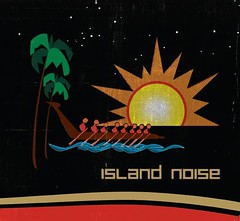
Blackdown: Hey Geiom, so lets’ start at the top: when did you start producing?
Geiom: Its been a while now - A friend and myself financed my first 12" back in 1995 - I only had one synth and drum machine at that time. I think I was still in the aftershock of rave, looking for new sounds and getting inspired by the more thoughtful styles of the Black Dog/AFX etc.
B: Where are you from/based?
G: I grew up in North London - Recently found out I went to the same school as SLT Mob - its a small world... I have been living in Nottingham for a long long time now. Don't believe the media hype - Nottingham is not the most dangerous place in the country! Its a great city but not the easiest to promote independent music events in.
B: How many releases have you had?
G: In terms of albums there has been: “Sellotape Flowers” as Geiom, “Magic Radios” as Kamal Joory, a collaboration with multi-instrumentalist Morgan Caney which is a hybrid of acoustic and electronic sounds. “See inlay for details” as Hem - experimental/glitchy/ambient project on Staalplaat. “Small medium” as Hem - collaboration with producer Metamatics.
One important event was the inclusion of Overnight Biscuits by Kode 9 on his dubstep Allstars 3 mix - I think this introduced me to the dubstep community and helped to start Berkane Sol. I will be releasing the new album 'Island Noise' on Berkane Sol in November. Berkane Sol has now had 5 12" releases. I have also put out many other singles and tracks on compilations over the years.

"Future Rustic" photo by Geiom
B: You mention Black Dog/AFX in your early (’95) influences and oddly I’d noticed this in your current material, I guess mostly in the synths and melodies. Do you still actively cite that era of electronica as a reference point? I ask this because in many ways the “inner” synth-lead, detailed/lite/chaotic percussion approach of Black Dog and AFX is in total opposition to the urban/black music approach of linear and physical percussion/bass pressure approach…
G: Its one influence for sure - I also like a lot of older electronic music like Eno, Tangerine Dream, Raymond Scott, you can find stuff made back in the 60's and 70's that still sounds like the future.
I think that both AFX and Black Dog started out with a more sound system style - Black Dog used to make jungle - so I don't think these particular artists are in opposition to physical music. Although AFX has made some deliberately awkward music in his time!
We saw Autechre playing live at the Bloc Weekend event earlier this year and their set showed influence from almost every electronic style I can think of, including dubstep and grime. What they were doing was totally physical and had tons of bass pressure – It was designed to engage the audience rather than alienate them, which is something that electronica can be found guilty of.
I've noticed that some people like Benga and Skream are using effects and edits that sound more like electronica than dubstep so I think stuff crosses over in all directions. I think the fact that Benga and Skream are best friends and make loads of very influential music together is proof that the idea of ‘black’ and ‘white’ music has become redundant, at least in certain communities.
B: With an electronica background, both as a fan and as a producer with releases on Staalplaat and in collaboration with Metamatics, how did you come to be interested in dubstep and what excites you about the music?
G: I was into grime mainly through helping local MC's to make beats. I like it a lot but it does annoy me sometimes, mainly when the lyrics are waste. But I have learnt a lot from the Nottingham hip hop and grime scenes.
I first heard dubstep properly when the FWD>> tour came to Nottingham - I think it was Kode 9, Youngsta, Oris J and Crazy D. I was led to believe that it was a grime event so I couldn't believe that the MC was hidden away with no ego and was just hosting more than taking centre stage. I was surprised by the variety of influences I could hear and in general just blown away by the experience. Sounds cheesy but its true.
B: You were born in north London but live in Nottingham. How has your environment, both in the past and more recently, influence your music?
G: My family moved out of London to the countryside when I was a teenager and it was during that time that I got into the emerging rave culture. I think I ended up wanting to make my own music partly out of rural boredom, partly because I thought I had something new to offer. Experiencing the non diverse culture that exists in most of Britain away from our cities (I was one of only two non white people at the school I ended up at) made me fully appreciate the importance of our immigrant populations.
B: You mention you think Nottingham has of late, had a bad rep, but why, despite being a nice university town, do you think it got its gun crime reputation alongside London, Manchester and Birmingham? Was Colin Gunn’s crime syndicate, that they recently took down solely to blame?
G: That was one aspect of it in a certain area. (Gun crime has gone down here by 90 percent since the syndicate was taken down ? not sure about that)
Its true that we have crazy territorial problems here – I only live less than half a mile from the city centre and know local youths that are scared to visit town. I know that a certain type of person actually feels empowered by the idea that their ends is a no go area for strangers, and actively tries to encourage that. I think that the media hype actually adds to that problem – people are aware that Nottingham is notorious. Sadly these people fail to realise that they are often imprisoned in their ends and hardly ever go anywhere else. Its interesting to note that London has always had high violent crime stats yet does not grab the headlines as much as other cities.
B: How did Kode9 come to know about “Overnight Biscuits” by yourself and what is the thinking behind Berkane Sol, both musically/label ethos and the name itself?
G: I sent Kode 9 a few CD’s and he seemed to get more into them over time – he cut some of the tunes and played stuff on Rinse. I sent tunes to loads of labels and got mostly no response at all. Decided to do it myself and it seems to have worked out well. The label is mainly for my own tracks but I have a couple of other people that I would like to release.
B: What’s the plan with your new album 'Island Noise' on Berkane Sol?
G: It’s a CD album of new tracks packed in some futuristic/surreal artwork by my designer friend Barret. I would rather just put out vinyl but I know there are a lot of people that don’t have a turntable, and I think my tunes are good to listen to at home/in the car as well as on a system.
I am inspired by all the sounds that exist around me and we live on an island, so the title is related to that and also other islands that figure strongly in my imagination – Mauritius, which is where my family is from, and Jamaica, which must be the most musically important small island on the planet.
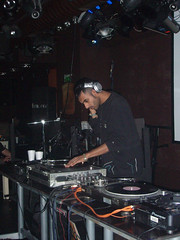
B: How did you come to get booked at DMZ? What is it like to play there?
G: I would like to think that I have maybe created my own small space within the dubstep sound/community and that DMZ appreciate that. It does feel like a real privilege to be asked – I learned a lot about the music from attending those events in the past and so it felt good to be on the other side of the booth. I have been getting more bookings abroad than in the UK so it was sweet to play at the most important UK event. DMZ has a special atmosphere created by the diverse crowd as well as the performers. It even brings people from as far away as the US to meditate and Mass has a heavy soundsystem. It’s been a real pleasure watching the event turn from a specialist night for the heads into a full on big rave over time.
B: Tell me about your work with vocalist Khalid? How do you know him and what was the thinking behind the release?
G: My girlfriend was organising a charity dinner after the Pakistan earthquake and we wanted some live music for it. I found Khalid in the process. He’s a big fan of Mohammed Rahfi, one of the singers I grew up listening to. He had some songs written for him in Pakistan some years back – it seems that you can pay for someone to write the lyrics and melodies for you. He had recorded them in a studio out there with session players – the recordings were cool but ruined by cheesy drum machine and home keyboard sounds.
So I chose one and got him to sing it over a dubstep tempo drum pattern I had put together. Then I built the music around the vocal – the tabla and sitar parts are programmed, I played the harmonium live and then edited it and did the same with the flute sections provided by my friend Dorian.
B: Tell me about the amazing LP track “Pheli Nazir?” What does the track name mean? Who is the vocalist and what was the thinking behind the track?
G: It means ‘first sight’ – it’s a love song, like most Indian pop music. It’s another track with Khalid (he wrote this one himself) and was made in the same way, but without the live instruments. I think it’s a good example of how diverse dubstep can be – “Zalim Maar Daala” is the same tempo but sounds much more hectic than this tune, which I think is pretty laid back.
B: Do you have any interest in the other desi/Asian/Far Eastern influences in dubstep?
G: I think tracks like the Loefah mix of Monsoon are hard to beat – it feels like a unified piece. I think some of the newer Asian sounding stuff is a bit ‘soundbite’ but I could say the same thing about a lot of the ‘stuck on’ sounding reggae samples that are being used at the minute. But I know from experience that its not easy writing an original Asian song from scratch and that mashing stuff together has often introduced people to sounds they didn’t know about.
B: What other genres of music excite you right now?
G: I listen to pretty much all styles of music – for example reggae/dub/ragga is a big influence, I loved rap ever since the breakdance era, I listen to a lot of (mainly older) Brazilian music, and I am fascinated by traditional music from many parts of the world. Characters like Sun Ra are inspirational on more than just a musical level, he had a whole mythology surrounding him. I love film soundtrack music but I don’t really get into ‘traditional’ classical orchestral music.
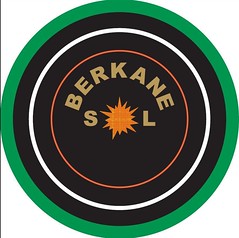
B: Jon Rust and Benny Ill from Horsepower rock the Berkane Sol t-shirts, Benny wearing his at the Tempa Radio 1 special recently. Are you going after Boy Betta Know’s t-shirt market? Are you going to do pink small tees for the ladies?
G: Already on that one – white small ladies shirts on sale now! Jon Rust always said the logo would look good on a shirt – we thought it might be a good way to get the label name and logo out of the record box – it’s the sort of thing that just gets hidden away in a stack of vinyl normally.
B: All this talk of “inner” sounds, what about looking out, to politics worldwide: is this something you follow? How do you feel about the terms “war on terror” and the “axis of evil?” Do either exist?
G: I can’t imagine anyone not taking an interest in some of the crazy stuff that is going on all over the place right now, I think it would be safe to say that if there is an ‘axis of evil’ then it centres around Wall Street and the other financial centres of the world. These institutions create and support misery on a scale the terrorists can only dream about. The other expression is totally dumb – how can you wage war on a concept? Is the military presence in Iraq and Afghanistan reducing our risk of terrorist attacks? – I don’t think so.
Sunday, October 28, 2007
From the ground
Time in Thailand meant space. Room to read. Choked by multiple channels digital media, my book reading has suffered in the last few years. Only when the plug’s pulled do I find the mental space. And boy, do I feel the benefits.
In an impulse airport buy, I picked up Malcolm Gladwell’s “The Tipping Point.” First published in the UK in 2000 (I know, I’m late…), it sets out to explain how given social phenomena, seemingly in contented equilibrium, can suddenly undergo explosive growth. The parallels with epidemiology and virology are strong.
Having read it, I guess I should admit I’m not sure I entirely buy “The Tipping Point.” Gladwell assembles disparate case studies and claims to find laws. There’s little scientific method nor attempt to eliminate whether a complex interaction of multiple forces was responsible for a given “tipping point,” rather than taking the easy route of pointing to the influence of, say, one sole Salesman. Yet to me its real value is in learning about the case studies he’s so painstakingly read up on, whether it’s crime in STD infections in Colorado or New York in the 1990s.
Yet within a few pages of “The Tipping Point,” I was dumbstruck how clearly there were parallels with dubstep’s growth. The year “The Tipping Point” is released in the UK, dubstep’s little more than a good idea (dark garage) contained in a handful of releases (Ghost 001, Tempa 001…) lost amongst the hype and success of UKG.
It continues its outsider status for nearly six years, largely derided (“it’s too slow,” “it’s too dark”, “when does it go off?”) by other genres (breaks, drum & bass, broken beat, mainstream dance, grime…), written off by most bloggers and totally ignored by the mainstream music press. It sells little but incubates quietly amongst a handful of committed DJs, producers and fans. While it experiences gentle growth beforehand, dubstep’s tipping point was clearly January 2006.
Malcolm Gladwell attributes scenes that “tip” to three factors:
• The Law of the Few
• Stickiness Factor
• Power of the Context
Of these three in relation to dubstep, “The Stickiness Factor” is by far the easiest to assign. Where in other social epidemics it might be less clear, here you can simply say “the music appealed to people.” I always felt it could. I can’t honestly say I knew if it would. In the end it has. Of course some tunes are stickier than other and the stickiest has important role as appeal means audience. At this time, no tune was stickier than Skream’s “Request Line” which burst the genre out of its confines, though the weight of multicolour tracks from Mala (“Neverland,” “Forgive,” “Changes” …) certainly helped.
“The Law of the Few” centres around the idea that certain types of people can have a disproportionate effect. He names three of them Connectors, Mavens and Salesmen.
In Gladwell’s world, the connectors are the facilitators, people who link, join and arrange. The classic example of this is Sarah Soulja from Ammunition. To this day people have no idea how much she did and still does for dubstep behind the scenes. Other, less clear cut, examples of connectors include Boomnoise, but also Barefiles and Rinse, who connected the fans to the music. Also the DJs and producers themselves, act as connectors as they spread their sound.
Then there’s Maven, people who ingest, rank and share vast amount of information about the scene. I guess at that time that was, well, probably myself and Gutterbreakz who probably came under this umbrella.
Then there’s Salesmen, evangelists, people who take the idea to the audience. This was clearly people like Boomnoise, Mary Anne Hobbs and George Drumz of the South. To an extent I’d also argue that clubs like FWD>>, DMZ and Subloaded were Salesmen, but perhaps they are more easily categorised using…
“The Power of the Context.” Where some of the other examples seem a little stretched, according to Gladwell’s definitions, “The Power of the Context” has blatant resonance with dubstep. To quote from “The Tipping Point:” “The Power of the Context: …in ways that we don’t necessarily appreciate, our inner states are the result of our outer circumstances.” How clearly does that resonate with the importance placed in dubstep around bass heavy, clear soundsystems installed into essential club environments like FWD>>, DMZ, Subloaded?
In a final twist in the correlations between “The Tipping Point” and dubstep, I did find a startling parallel between some of his ideas around The Power of the Context and some of my Keysound thinking, the ideas that underpin our label.
Here’s something I wrote recently about Keysound Recordings:
“In ways that we don’t necessarily appreciate, our inner states are the result of our outer circumstances.”
Or his explanation of a concept called FAE:
Using criminologists James Q Wilson and George Kelling’s “Broken Windows” theory, Gladwell points to the power of cleaning up the New York subway and its positive effect on crime rates.
A late twist to this train of thought came to me when I returned to London. I was talking to, well let’s just identify the person as a Rinse insider, who was describing the funky house nights going on out east right now. I didn’t write down the quotes, so here’s a loose paraphrasing.
“There’s no trouble though…” said the insider, despite this being exactly the same audience/demographic/location as grime. Perhaps, surrounded by well dressed people, a individual behaves differently? Frankly that isn’t such a revelation, think about the number of times you’ve dressed up and been on your best behaviour.
But then I think back to the one time I went to Twice As Nice in 1998 at The End. At that time it was the quintessential UK garage rave. Then a few months later, someone who may or may have not have been at the club got shot about half a mile from the venue.
In fact I remember one senior urban journalist telling me once, “mate, it’s not the new school (grime) MCs you gotta look out for, it’s the old school garage mafia…”
Hmm. Am I looking through “broken windows?” or a prism reflecting many complex colours.
In an impulse airport buy, I picked up Malcolm Gladwell’s “The Tipping Point.” First published in the UK in 2000 (I know, I’m late…), it sets out to explain how given social phenomena, seemingly in contented equilibrium, can suddenly undergo explosive growth. The parallels with epidemiology and virology are strong.
Having read it, I guess I should admit I’m not sure I entirely buy “The Tipping Point.” Gladwell assembles disparate case studies and claims to find laws. There’s little scientific method nor attempt to eliminate whether a complex interaction of multiple forces was responsible for a given “tipping point,” rather than taking the easy route of pointing to the influence of, say, one sole Salesman. Yet to me its real value is in learning about the case studies he’s so painstakingly read up on, whether it’s crime in STD infections in Colorado or New York in the 1990s.
Yet within a few pages of “The Tipping Point,” I was dumbstruck how clearly there were parallels with dubstep’s growth. The year “The Tipping Point” is released in the UK, dubstep’s little more than a good idea (dark garage) contained in a handful of releases (Ghost 001, Tempa 001…) lost amongst the hype and success of UKG.
It continues its outsider status for nearly six years, largely derided (“it’s too slow,” “it’s too dark”, “when does it go off?”) by other genres (breaks, drum & bass, broken beat, mainstream dance, grime…), written off by most bloggers and totally ignored by the mainstream music press. It sells little but incubates quietly amongst a handful of committed DJs, producers and fans. While it experiences gentle growth beforehand, dubstep’s tipping point was clearly January 2006.
Malcolm Gladwell attributes scenes that “tip” to three factors:
• The Law of the Few
• Stickiness Factor
• Power of the Context
Of these three in relation to dubstep, “The Stickiness Factor” is by far the easiest to assign. Where in other social epidemics it might be less clear, here you can simply say “the music appealed to people.” I always felt it could. I can’t honestly say I knew if it would. In the end it has. Of course some tunes are stickier than other and the stickiest has important role as appeal means audience. At this time, no tune was stickier than Skream’s “Request Line” which burst the genre out of its confines, though the weight of multicolour tracks from Mala (“Neverland,” “Forgive,” “Changes” …) certainly helped.
“The Law of the Few” centres around the idea that certain types of people can have a disproportionate effect. He names three of them Connectors, Mavens and Salesmen.
In Gladwell’s world, the connectors are the facilitators, people who link, join and arrange. The classic example of this is Sarah Soulja from Ammunition. To this day people have no idea how much she did and still does for dubstep behind the scenes. Other, less clear cut, examples of connectors include Boomnoise, but also Barefiles and Rinse, who connected the fans to the music. Also the DJs and producers themselves, act as connectors as they spread their sound.
Then there’s Maven, people who ingest, rank and share vast amount of information about the scene. I guess at that time that was, well, probably myself and Gutterbreakz who probably came under this umbrella.
Then there’s Salesmen, evangelists, people who take the idea to the audience. This was clearly people like Boomnoise, Mary Anne Hobbs and George Drumz of the South. To an extent I’d also argue that clubs like FWD>>, DMZ and Subloaded were Salesmen, but perhaps they are more easily categorised using…
“The Power of the Context.” Where some of the other examples seem a little stretched, according to Gladwell’s definitions, “The Power of the Context” has blatant resonance with dubstep. To quote from “The Tipping Point:” “The Power of the Context: …in ways that we don’t necessarily appreciate, our inner states are the result of our outer circumstances.” How clearly does that resonate with the importance placed in dubstep around bass heavy, clear soundsystems installed into essential club environments like FWD>>, DMZ, Subloaded?
In a final twist in the correlations between “The Tipping Point” and dubstep, I did find a startling parallel between some of his ideas around The Power of the Context and some of my Keysound thinking, the ideas that underpin our label.
Here’s something I wrote recently about Keysound Recordings:
“What is Keysound thinking?Contrast this with Gladwell’s The Power of the Context:
Around 2005 I found myself returning to, in essence, the same question: why is so much of the music from London, from jungle to grime to dubstep, so dark? What was it that unified all these producers in their love of dark, edgy beats? Again and again, I came back to the same conclusion. Of those making dark beats in London, the only single factor that united everyone - from all backgrounds, gender, ethnicity, age or class - was their London surroundings.”
“In ways that we don’t necessarily appreciate, our inner states are the result of our outer circumstances.”
Or his explanation of a concept called FAE:
“The mistake we make in thinking of character as something unified and all-encompassing is very similar to a kind of blind spot in the way we process information.
Psychologists call this tendency the Fundamental Attribution Error (FAE), which is a way of saying when it comes to interpreting other people’s behaviour, human beings invariably make the mistake of overestimating the importance of fundamental character traits and underestimating the importance of the situation and the context.”
Using criminologists James Q Wilson and George Kelling’s “Broken Windows” theory, Gladwell points to the power of cleaning up the New York subway and its positive effect on crime rates.
By extension perhaps London’s grimey surroundings are responsible for its dark music epidemic?
“Muggers and robbers whether opportunistic or professional, believe they can reduce their chances of being caught or even identified if they operate on streets where the potential victims are already intimidated by prevailing conditions. If the neighbourhood cannot keep a bothersome panhandler from annoying passersby, the thief may reason, it is less likely to call the police to identify a potential mugger or to interfere if the mugging actually takes place.”
A late twist to this train of thought came to me when I returned to London. I was talking to, well let’s just identify the person as a Rinse insider, who was describing the funky house nights going on out east right now. I didn’t write down the quotes, so here’s a loose paraphrasing.
Apart from my obvious curiosity about “a new UK garage,” despite my musical narcolepsy, sorry reservations, about funky house, a parallel appeared to me with Kelling’s “Broken Windows” theorem.
“I’ve been to some funky house after parties that you’d love. Out east, some grimey venue, all girls and ghetto kids. Everyone’s dressed up, no hoods or trainers. It’s exactly like UK garage again. The music’s London funky house, except the ghetto kids are starting to make it now too. It's unclear, but in a minute it will be something. There’s no trouble though, perhaps the dress policy keeps them away…”
“There’s no trouble though…” said the insider, despite this being exactly the same audience/demographic/location as grime. Perhaps, surrounded by well dressed people, a individual behaves differently? Frankly that isn’t such a revelation, think about the number of times you’ve dressed up and been on your best behaviour.
But then I think back to the one time I went to Twice As Nice in 1998 at The End. At that time it was the quintessential UK garage rave. Then a few months later, someone who may or may have not have been at the club got shot about half a mile from the venue.
In fact I remember one senior urban journalist telling me once, “mate, it’s not the new school (grime) MCs you gotta look out for, it’s the old school garage mafia…”
Hmm. Am I looking through “broken windows?” or a prism reflecting many complex colours.
Thursday, October 25, 2007
Rinse@Cargo
Rinse @ Cargo Thurs 1st Nov: ya dun know the club space. Featuring Boy Betta Know, Jammer, Ghetto, Spyro, Skream, Scratcha and JJ, Jelly Jams, Circle, Youngsta, Benga, Supa D, SK Vibemakers, Katie...
Subscribe to:
Comments (Atom)
